人民币国际化相关的文献综述
《人民币国际化》论文
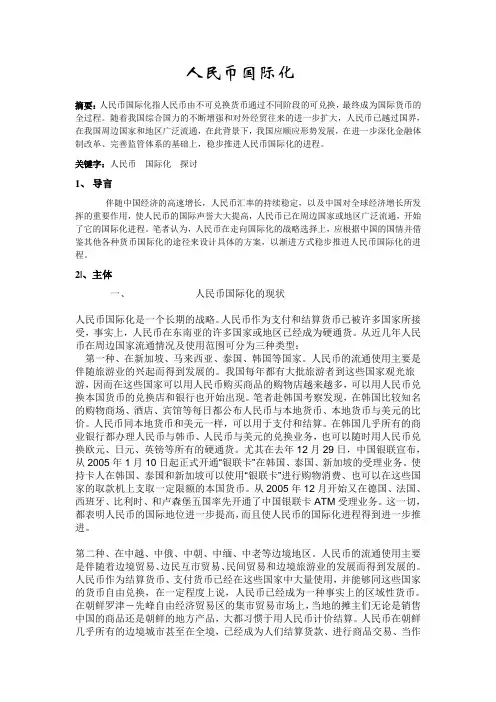
人民币国际化摘要:人民币国际化指人民币由不可兑换货币通过不同阶段的可兑换,最终成为国际货币的全过程。
随着我国综合国力的不断增强和对外经贸往来的进一步扩大,人民币已越过国界,在我国周边国家和地区广泛流通,在此背景下,我国应顺应形势发展,在进一步深化金融体制改革、完善监管体系的基础上,稳步推进人民币国际化的进程。
关键字:人民币国际化探讨1、导言伴随中国经济的高速增长,人民币汇率的持续稳定,以及中国对全球经济增长所发挥的重要作用,使人民币的国际声誉大大提高,人民币已在周边国家或地区广泛流通,开始了它的国际化进程。
笔者认为,人民币在走向国际化的战略选择上,应根据中国的国情并借鉴其他各种货币国际化的途径来设计具体的方案,以渐进方式稳步推进人民币国际化的进程。
2|、主体一、人民币国际化的现状人民币国际化是一个长期的战略。
人民币作为支付和结算货币已被许多国家所接受,事实上,人民币在东南亚的许多国家或地区已经成为硬通货。
从近几年人民币在周边国家流通情况及使用范围可分为三种类型:第一种、在新加坡、马来西亚、泰国、韩国等国家。
人民币的流通使用主要是伴随旅游业的兴起而得到发展的。
我国每年都有大批旅游者到这些国家观光旅游,因而在这些国家可以用人民币购买商品的购物店越来越多,可以用人民币兑换本国货币的兑换店和银行也开始出现。
笔者赴韩国考察发现,在韩国比较知名的购物商场、酒店、宾馆等每日都公布人民币与本地货币、本地货币与美元的比价。
人民币同本地货币和美元一样,可以用于支付和结算。
在韩国几乎所有的商业银行都办理人民币与韩币、人民币与美元的兑换业务,也可以随时用人民币兑换欧元、日元、英镑等所有的硬通货。
尤其在去年12月29日,中国银联宣布,从2005年1月10日起正式开通“银联卡”在韩国、泰国、新加坡的受理业务。
使持卡人在韩国、泰国和新加坡可以使用“银联卡”进行购物消费、也可以在这些国家的取款机上支取一定限额的本国货币。
从2005年12月开始又在德国、法国、西班牙、比利时、和卢森堡五国率先开通了中国银联卡ATM受理业务。
人民币国际化收益与成本分析文献综述
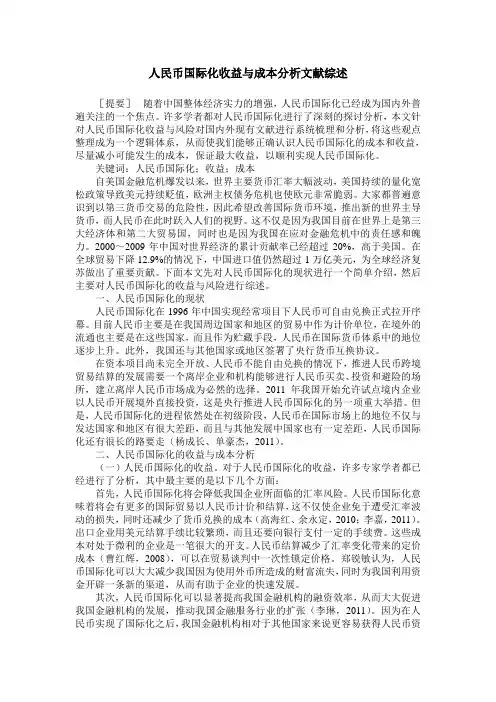
人民币国际化收益与成本分析文献综述[提要]随着中国整体经济实力的增强,人民币国际化已经成为国内外普遍关注的一个焦点。
许多学者都对人民币国际化进行了深刻的探讨分析,本文针对人民币国际化收益与风险对国内外现有文献进行系统梳理和分析,将这些观点整理成为一个逻辑体系,从而使我们能够正确认识人民币国际化的成本和收益,尽量减小可能发生的成本,保证最大收益,以顺利实现人民币国际化。
关键词:人民币国际化;收益;成本自美国金融危机爆发以来,世界主要货币汇率大幅波动,美国持续的量化宽松政策导致美元持续贬值,欧洲主权债务危机也使欧元非常脆弱。
大家都普遍意识到以第三货币交易的危险性,因此希望改善国际货币环境,推出新的世界主导货币,而人民币在此时跃入人们的视野。
这不仅是因为我国目前在世界上是第三大经济体和第二大贸易国,同时也是因为我国在应对金融危机中的责任感和魄力。
2000~2009年中国对世界经济的累计贡献率已经超过20%,高于美国。
在全球贸易下降12.9%的情况下,中国进口值仍然超过1万亿美元,为全球经济复苏做出了重要贡献。
下面本文先对人民币国际化的现状进行一个简单介绍,然后主要对人民币国际化的收益与风险进行综述。
一、人民币国际化的现状人民币国际化在1996年中国实现经常项目下人民币可自由兑换正式拉开序幕。
目前人民币主要是在我国周边国家和地区的贸易中作为计价单位,在境外的流通也主要是在这些国家,而且作为贮藏手段,人民币在国际货币体系中的地位逐步上升。
此外,我国还与其他国家或地区签署了央行货币互换协议。
在资本项目尚未完全开放、人民币不能自由兑换的情况下,推进人民币跨境贸易结算的发展需要一个离岸企业和机构能够进行人民币买卖、投资和避险的场所,建立离岸人民币市场成为必然的选择。
2011年我国开始允许试点境内企业以人民币开展境外直接投资,这是央行推进人民币国际化的另一项重大举措。
但是,人民币国际化的进程依然处在初级阶段,人民币在国际市场上的地位不仅与发达国家和地区有很大差距,而且与其他发展中国家也有一定差距,人民币国际化还有很长的路要走(杨成长、单豪杰,2011)。
人民币国际化范文
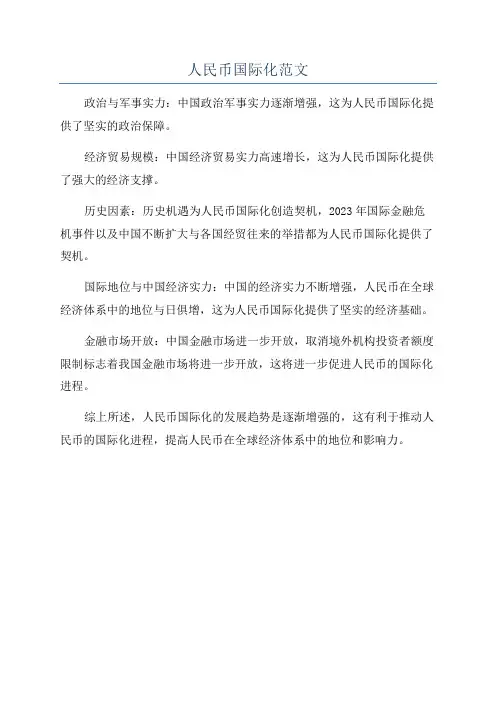
人民币国际化范文
政治与军事实力:中国政治军事实力逐渐增强,这为人民币国际化提供了坚实的政治保障。
经济贸易规模:中国经济贸易实力高速增长,这为人民币国际化提供了强大的经济支撑。
历史因素:历史机遇为人民币国际化创造契机,2023年国际金融危机事件以及中国不断扩大与各国经贸往来的举措都为人民币国际化提供了契机。
国际地位与中国经济实力:中国的经济实力不断增强,人民币在全球经济体系中的地位与日俱增,这为人民币国际化提供了坚实的经济基础。
金融市场开放:中国金融市场进一步开放,取消境外机构投资者额度限制标志着我国金融市场将进一步开放,这将进一步促进人民币的国际化进程。
综上所述,人民币国际化的发展趋势是逐渐增强的,这有利于推动人民币的国际化进程,提高人民币在全球经济体系中的地位和影响力。
人民币国际化相关的文献综述
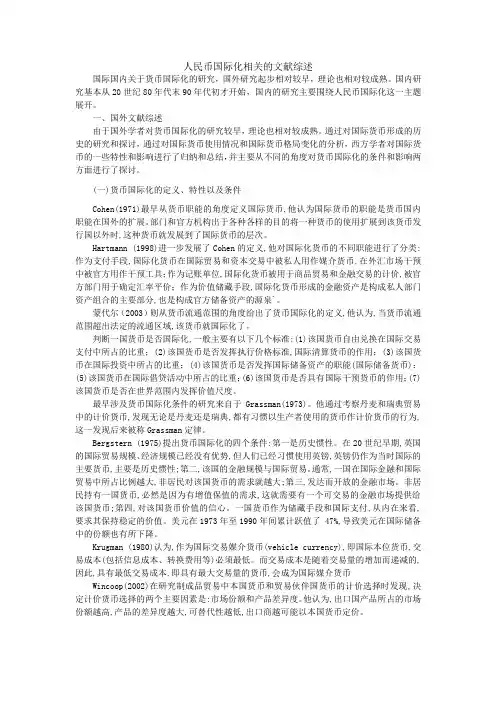
人民币国际化相关的文献综述国际国内关于货币国际化的研究,国外研究起步相对较早,理论也相对较成熟。
国内研究基本从20世纪80年代末90年代初才开始,国内的研究主要围绕人民币国际化这一主题展开。
一、国外文献综述由于国外学者对货币国际化的研究较早,理论也相对较成熟。
通过对国际货币形成的历史的研究和探讨,通过对国际货币使用情况和国际货币格局变化的分析,西方学者对国际货币的一些特性和影响进行了归纳和总结,并主要从不同的角度对货币国际化的条件和影响两方面进行了探讨。
(一)货币国际化的定义、特性以及条件Cohen(1971)最早从货币职能的角度定义国际货币,他认为国际货币的职能是货币国内职能在国外的扩展。
部门和官方机构出于各种各样的目的将一种货币的使用扩展到该货币发行国以外时,这种货币就发展到了国际货币的层次。
Hartmann (1998)进一步发展了Cohen的定义,他对国际化货币的不同职能进行了分类:作为支付手段,国际化货币在国际贸易和资本交易中被私人用作媒介货币,在外汇市场干预中被官方用作干预工具;作为记账单位,国际化货币被用于商品贸易和金融交易的计价,被官方部门用于确定汇率平价;作为价值储藏手段,国际化货币形成的金融资产是构成私人部门资产组合的主要部分,也是构成官方储备资产的源泉`。
蒙代尔(2003)则从货币流通范围的角度给出了货币国际化的定义,他认为,当货币流通范围超出法定的流通区域,该货币就国际化了。
判断一国货币是否国际化,一般主要有以下几个标准:(1)该国货币自由兑换在国际交易支付中所占的比重;(2)该国货币是否发挥执行价格标准,国际清算货币的作用;(3)该国货币在国际投资中所占的比重;(4)该国货币是否发挥国际储备资产的职能(国际储备货币);(5)该国货币在国际借贷活动中所占的比重;(6)该国货币是否具有国际干预货币的作用;(7)该国货币是否在世界范围内发挥价值尺度。
最早涉及货币国际化条件的研究来自于Grassman(1973)。
人民币国际化外文文献及文献综述
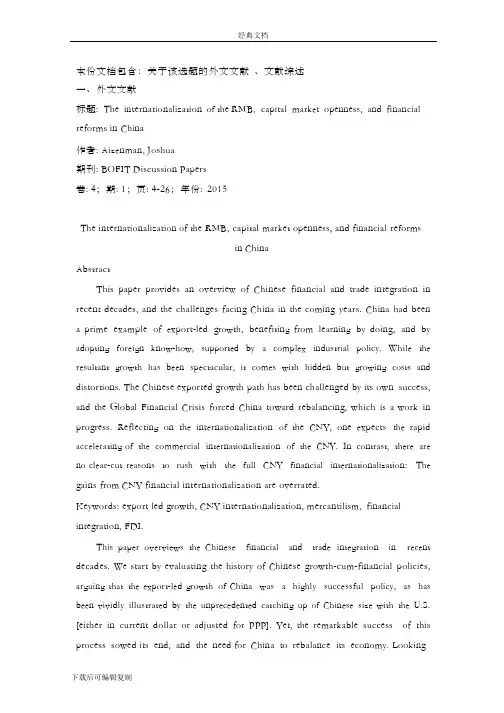
本份文档包含:关于该选题的外文文献、文献综述一、外文文献标题:T hei n ternat i onal i za t ion oft heRMB,capit a lm a r ke tope nn es s,an dfi na ncia l reformsinC hi na作者: Aizenman,Joshua期刊: BOFIT DiscussionPapers卷: 4;期: 1;页: 4-26;年份:2015T hei n ternat i onaliz a ti ono f t heRMB,capi t almarke t openne s s,andfi n an c ialre f orm s inChina AbstractThis paper provides an overview of Chinese financial and trade integrationinrecentdecades,andthechallengesfacingChinainthecomingyears.Chinahadbee napr i meexampleof e xport-ledg row t h,benefi t in g fromle a r ni n g b y doing,andby adoptingforeignknow-how,supportedbyacomplexindustrialpolicy.Whiletheresultant growth has been spectacular, it comes with hidden but growing costs and distortions. The Chinese exported growth path has been challenged by its ownsuccess,and the Global Financial Crisis forced China toward rebalancing, which is a workinprogress.Refle c ti ng onth e int e r na ti on alizati onoft heCNY,one e xpect s t he rapid accelera ting of the commercial internationalization of the CNY. In contrast, there areno clear-cut reasons to rush with the full CNY financial internationalization: The gains from CNY financial internationalization areoverrated.Keywords: export led growth, CNY internationalization,mercantilism,financialintegration,FDI.This paper overviews the Chinese financial and tradeintegration in recent decades. We start by evaluating the history of Chinese growth-cum-financialpolicies,arguingthattheexport-ledgrowthofChina was a highly successful policy, as hasbeenvividlyillustratedbytheunprecedentedcatchingupofChinesesizewiththeU.S.[either in current dollar or adjusted for PPP]. Yet, the remarkable success ofthisprocess sowed its end, and the need for China to rebalance its economy.Lookingforward,wepointoutthelogicofsequencing financial reforms. Whileone expects the rapid acceleration of commercial internationalization of the CNY, and thegrowing useofCNYinthesphereofChinesecommercialandoutwardFDItransactions,there are no c lear-c utrea s onstorus h witht h efullCNYint e rnat i onali z a t ion.Cha nc es a rethat the gains from a rapid CNY financial internationalization are overrated,and ignoringthedownsidesofthisprocesswouldbe to Chinese (and probably global)peril.1The buoyant2000sChi na has been a prime example of export-le d growth, benefi t ing from l ea r ningby doing, and by adopting foreign know-how, supported by a complexindustrial policy.Thispolicyhas beencharacterizedbycontrolledopenness,and internal financial repression. The financial repression has taxed the saving interestrate,allowing prime borrowers, including the Chinese state-owned enterprise (SOE),el a stic ac c ess t o c h eap a nd sus t ai n able funding. FDI has be en w e lcome, subjec tt o China'srulesofthegame.TheserulesleveragedthecarrotofChinesemarketsizeandchea plabor,inducingtheforeigninvestortooperateinChinainjointventure partnership with Chinese producers (Holmes et al. 2013). The outcome has beenrapidlearning by doing and transfer of know-how and the rapid climb of China onthela dde rof i ndus t ria l sophistic a ti on,chal l eng i ngfor e ignproduc e rsint he Chine s eand third-country markets down theroad.1Arguably, a modem version of mercantilism has been at work (Aizenman and Lee 2007, 2008). The rapid growth and the growing trade and currentaccountsurpluses as a fraction of the GDP has occurred in tandem with massive hoardingofinternational reserves (IR) combined with massive sterilization of expendingtrade surplusesandfinancialinflows.Thesepoliciesaimedatdelayingandslowingthere al appreciation associated with successful rapid growth. While the resultant growthhas beenspectacular,itcomeswithhidden,butgrowing,costsanddistortions.Figure1,inthe top panel, provides diamond chart snapshots of Chinese generalized trilemma configuration: Financial integration (leftward from the diamond's center),Monetaryindependence (vertically upward from the diamond's center),Exchange rate stability(rightwardfromthediamond'scenter),andIR/GDP(verticallydownwardfromthe diamond's center). The first three scales are capturing Mundell's openeconomy trilemmaconfigurations,normalizedbetween0and1(Aizenman,Chinn,andIto2010).TheIR/GDP aim sa tcapturin g t heg row ing useofinte rna ti ona lr e se rve s t obuffer against financial instability. The chart exhibits the remarkable stability ofthe Chineseexchangerateduringthe1990sandthe2000s,bufferedbyrapidincreasesin IR/GDP, while maintaining controlled financial integration and monetary independence.Figure1alsoputsChineseexperiencein thecontext oftheaverage exp e rience of e mergin g As i a [ excl u din g Chi na] and emerging Latin A me r i cadu ri ngthe same decades (the middle and the lower panel, respectively). The charts validate thegreaterfocusofChineseexperienceonexchangerate stabilityandIR hoarding,while overall maintaining limited financial integration relative to otheremergingmarkets.In t he r un-up t o the fina nc ial cris i s, t h e world e c onomy was c hara c terizedby enormouscurrent-accountimbalances(Figure2).China's surplus alone was0.7%ofworldGDPin2008,whiletheUnitedStateshadadeficitofmorethan1%ofworld GDP that year. The current account balances of the world's surplus countries(e.g.,China, Germany, Japan, oil exporters) exceeded 2.5% of global GDP in2008,co-fundin g the curre nt accoun t ba lanc e s of t he world's de ficit co unt rie s, mostly t heUnited States, non-Asian emerging markets, and the Euro area excluding Germany.In the early 2000s, some suggested large imbalances could be sustained forthe foreseeable future. Dooley, Folkerts-Landau, and Garber (2003, 2005) argued anAsian periphery, primarily China, could pursue a development strategy ofexport-ledgrowth supported by undervalued exchange rates and capital controls for rgecurrentaccountsurplusesandofficialcapitaloutflowsinthe form of accumulated reserve asset claims on the United States would characterize theAsian peripheryforperhapsadecadeormore.Moreover,thestrategywasa"win"forthecenter(e.g.,theUnitedStates)aswell,sincevirtuallyunlimiteddemandforits financialassetswouldallowitt orunlargecurrentaccountdeficits,livingbeyonditsmeans foryears.At some point, the Asian periphery would grow sufficiently to graduate to the center. It would then undertakefinancial liberalization and adopt greater exchange-rate flexibility. But when that happened, another set of developing countries w oul d st e p fo rw ard t o b ecome th e new p e riph e ry, pursuin g the s ame e x port-l e dgrowth strategy against the center as had China and the Asian periphery, andbefore them,post-warEuropeandJapan.Asaresult,globalimbalances,withtheperiphery running large current-account surpluses and the center large current-accountdeficits,wouldbearegularfeatureoftheinternationalmonetarysystemforyears to come.D ool eye t al.(2005)pro vi deda n asse t ma r ket i nte rp ret a tion of the w in-winvie w ofglobalimbalances:U.S.deficitssuppliedinternationalcollateraltopoorercountrie s ontheperipheryeagertoundertakecapitalformation;thecollateralfreedthemfroma reliance on inefficient domestic financialmarkets.2The modem mercantilist view, embraced by Aizenman and Lee (2007, 2008)andothe rs, provided a less s a ng ui ne i nt e r pret a tion for the persistent globa l im b alancesthat emergedinthe2000s.WhileAizenmanandLee(2007)confirmedthatthehoarding ofinternationalreservesthataccompaniedcurrent-accountsurpluseswasdominatedbya precautionary motive prior to 2001, a finding consistent with Aizenman andMarion's(2003) earlier interpretations, there appeared to be a regime changeafterward.A i z enm an and Lee (2008) poi nt ed to t he g rowingimport a nc e of mone t ar ymercantilismasthemainreasonfortheregimechange. Accordingly, following theAsiancrisisof1997-8,whichmitigatedChinese competitiveness in the late 1990s,and the Chinese accession to the WTO in early 2000s, China intensified itsdrivetoward export-led growth. Like earlier mercantilist efforts to expand exportmarketsand accumulate gold described by Adam Smith (1776), after the year 2000,countries suchasChinastartedpushingexportstopromotegrowth,rackingupcurrent-account surpluses and growing stockpiles of internationalreserves. The numberswere impressive. On the eve of the financial crisis, China's real GDP growth had reachedabout 14% (Fig. 3), its current-account surplus had grown to 10% of GDP, and its international reserves had reached almost 45% of GDP prior to the crisis, peakingatabout 50% in 2010 (Fig. 3). However, unlike Dooley's et al. (2003,2005)win-winviewofglobalimbalancesbufferedbyinternationalreservehoarding,Aizenmanand Lee (2008) noted that modemmercantilism could lead to unintendedadverse consequences,suchascompetitivehoarding.Thisconcernisinlinewiththefin dings ofCheungand Q i a n(2009)andA i z enm anetal.(2014)supporti ng re g i o nal r ivalryinhoardi ng internationalreserves.The view that large East-West global imbalances could be sustained for along period was not shared by everyone. Eichengreen (2007) and Feldstein (2008),for example,arguedtheAsianperipherywasnotmonolithic;somememberofthe periphe r y m ightabandonfix e dex c hang e ra t esag a instt he doll a rso one rt ha nla t er,either willingly or in response to speculative pressures, thereby reducingEast-West globalimbalances.ObstfeldandRogoff(2005) alsosawlargeimbalancesas unsustainable, and worried whether they would unwind gradually or abruptly.Alfaro,Kalemli-Ozcan, and Volosovych (2011) observed that global imbalances wherepoorercountri e s fin a n c ed ric h e r ones we r e drive n ma inl y by government deci s i o ns a nd officialcapitalflows,sinceprivatefundstendedtomoveintheoppositedirection,attractedbyhig hergrowthratesinpoorercountries. Theyraisedconcerns aboutthe global efficiency and sustainability of thesetrends.Aizenman and Sun (2010) also raised doubts that large global imbalancescouldbe sustaina bl e. They argued that wit h C hi na growing a t tri pl e the r a t e of theUn i ted States,theU.S.current-accountdeficitsneededtoabsorbChina'ssurplusesincomingyears, intheabsenceofotherbigcountrieswillingtorunlargedeficits,wouldbe unrealistically high and hence self-limiting in the not-too-distantfuture.2The global financial crisis and China'sadjustmentThe global financial crisis of the late2000s put an abrupt end tothe happy-go-luckyattitudetoU.S.andChineseimbalances.Inthe U.S., the private sectorwasforcedtodeleverageandreduceditsdemandforimports.Othercrisis-hit developed countries also cut back on imports. As China experienced weaker exportdemand,ittookseriouslytheIMF's callformorerelianceon domestic spending to sustain growth. It began promoting greater domestic consumption andinvestmentwith thehelp of a domestic credit boom. It also pursued fiscal stimulus and alloweditsreal exchangeratetoappreciate(Fig.4).It attemptedtodiversify itsholdingsof dollar-denominated reserve assets by creating a sovereign wealth fund and encouraging outward foreign directinvestment.Sta nda rd macroeconomi c mode l s can acc ountfor th e reduc t ion i n globa l imbalances in the immediate aftermath of a financial crisis. Financial frictionsand householdde-leveragingreduceimportdemandaswellasaggregatedemandin crisis-hit countries, reducing their current-account deficits. If weak demandimpacts manycountries,therearefewtotakeuptheslack.Countrieswithlarge current-account s urpl uses, such as China, faced co l lapsing d em a nd for theirexpor t sand experienced declining current-account surpluses. Policies that stimulatedomestic demandtomakeupfortheexportshortfallcanreducecurrent-accountsurpluseseven more. In Aizenman, Jinjarak, and Marion (2013), we explore panel regressions asaway to highlight important correlationsbetween currentaccountbalances andec on omic vari a bles, both before a nd a f ter the financial crisi s. T he r es ults indicatea structuralchangepost-crisis.ThedeclineinChina'sreservestockpile post-crisis isshownto bedrivenbyanewwaveofoutwardforeigndirectinvestment(FDI)into developed economies as China seeks higher-yielding real foreign assets.Thesedevelopments suggest that China'ssmaller current-account surpluses andmoremo de r a terese r veaccumul a ti o nmaybecomea l onge r-term no rmasl o w e r g l ob al growthforcesChinatorelymoreondomesticdemandtoexpanditsecono my,andasthehighcostofholdinginternationalreservespushesChinatoplaceevenmore emphasis on outwardFDI.We assembled panel data on current-account balances and othereconomicvariables for a group of developed and developing countries over theperiod1980-2012.TheestimationdrawsontheempiricalframeworkinChinnandPrasad(2003) and Gruber and Kamin (2007). The specification also includes the U.S.demandvariable(measuredbytheU.S.current-accountdeficitasapercentofGDP)usedinAizenmanandJinjarak(2009)tocapturethe notionthattheU.S.actedasa"demander of last resort" for the exports of China and othercountries, enabling themto run big current-account surpluses over part of the sampleperiod.The estimates confirm that a structural change has taken place post-crisis.After the onset of the financial crisis, the United States no longer plays such an important roleas"demanderoflastresort"fortheexportsofothercountries. Its private and publi c se c torshav eh adtounder g osubstantialadj us t m ents,making t hemle s sable t oabsorb the world's exports. The U.S. private sector has had to de-leverage in response tothenegativewealtheffectsofdecliningrealestateandportfoliovaluations.These privat e and public sector adjustments post-crisis have required the U.S. to retreatfrom its role as "demander of last resort" for the world'sexports.P ri or t o the fina nc ia l cri s i s, the c ur rent accounts of sur pl us c ou ntr ie s a r epositively and significantly associated with the increase in international reserves,trade,andthein-creaseintheU.S.current-accountdeficit.Afterthefinancialcrisis,thefirst two correlations are insignificant and the correlation with U.S. demand reverses sign;it is now negative and significant. The role of the U.S. as a "demander of last resort"isdiffer e nt after2006.The GFC vividly illustrated the limits of the export-led growth; the Chineseexport-ledgrowthpathhasbeenchallengedbyitsownsuccess. The spectacular growth of China in the 2000s was unprecedented for a large economy-theU.S./Chinamarket size in current U.S. dollars dropped from 8 in 2000, to about 2 in 2010 [ Fig.5].TheEconomistproj e ct e din2014t ha tby2022,Chin a'ssiz e in c urrentU.S.dolla rswoulde xceedthatoftheU.S.AsChinaapproachesthe U.S.size,itsabilitytokeepexport-led growth was diminished substantially by the lackluster growth of the U.S and the Eurozone, inducing lower growth of China, and promoting it to embarkoninternalrebalancing.3Internal rebalancing: Challenges andopportunitiesWhile China's growth has been spectacular, it comes with hidden, but growing,costs and distortions. The GFC and the need to rebalance the growth strategy, andthe greater recognition of the demographic transitions facing leading countries in generalandChinainparticular,puttotheforeChina'sgreater exposure to tail risks. We review in this section several manifestations of theserisks.Chinese financial repression has resulted in the taxing of privatesaving,transferringthemviathestatebankingsystemandother means to the SOE.Subsidizing the cost of SOE capital helped in facilitating fast Chinese growth inthe earlierdecadesofthetakeoff,yetitcomeswiththecostoftheSOE'soverinvestment bias,i nduc ing fa s t e rdi mi n ishingma r ginal produ ctivityo f theSOE,a ndre s ul t ingingrowing quasi-public contingentliabilities.The other side of financial repression has been the fragmentation offinancial intermediation,wheresmallprivatefirmsarenotservedadequatelybytheofficial ba nks,butbyshadowbanking.Thedrawbackisthatthesmall andmediumprivate secto r, which over t ime provides b r ig hte r future gr o wth pros pe cts t han th e SOE,fac es much higher real interest rates and greater rollover risks. The outcome hasbeen growingproductivitygapsinfavoroftheprivaterepressedfirms(Lardy(2008),Song et al.(2014)).AnothercostofChinesepoliciesmaybethecollateraldamageofmercantilism,th e rapi dr i s eof c os tlyhoardinginternat i onal r e s e r vesi n t i me s of ru nni ng l a rge currentaccountsurpluses,asreflectedinFig.3.AccordingtotheStateAdministrationofForei gnExchange(SAFE),China'sexternalfinancial assets at the end of 2013were about U.S. $6 trillion, of which international reserves were about 2/3 (U.S.$3.9trillion), the outbound direct investment (ODI) about 10%, securities investmentabout4%,a nd otherinv es t m ent a t a bout20%.T hecountry's e xt e rnalli a bility p ositio nwasU.S.$4trillion,outofwhichFDIinChinawas$2.35trillion,60%oftotalliability.Theinvestmentins ecuritiesandotheraspectstookup10%and30%,respectively.Therefore, China's net external financial assets in 2013 was about U.S. $2 trillion.3Yet, the real net return on these assets was, at best, close to zero, or evennegative.This reflects two fundamental factors. The first is the low real return onChinese internationalreserves(2/3ofitsgrossexternalassets),whichinturnreflectsboththe low nominal interest rate on internationalreserves and the real exchangerate appreciationofChina.ThesecondisthehighreturnontheinwardFDI,about60%ofC hineseexternalliabilities.ThelowreturnonChineseforeignassetsisbadnews,especially considering the rapid aging of China's population. This is in contrasttoJapan, where thesizable return on Japan's foreign asset position helps in buffering thefuture income of its rapidly grayingpopulation.The policy stance of China during and after the GFC may mitigate down theroad thehiddencostsofChinesefinancialrepression.First,China embarked on dive rs i f yingit shol dingsof dol la rI Rbyc h anne l ings ur plus e sintoas ove reignwea l thfund (SWF) and encouraging outward foreign direct investment in tangibleassets,offeringmuchhigherexpectedreturns.4TheoutcomehasbeengrowingFDIinthe r esource sectors and infrastructure services globally, especially inunderserviced developingcountriesandemergingmarketsinAfricaandLatinAmerica.Inaway,China joine d the trend o f other EMs, as de t ected in Aizenma n and Pasricha(2013),noting that EMs eased outflows of capital more in response to higher stockprice appreciation,higherappreciationpressuresin the exchange market, higher IR/GDP,and higher REERvolatility.The GFC and its aftermath also induced rapid Chinese internalbalancing,reduci n g t he sco pe of future hoarding. Sinc e the c risis, China's c urrent-a c c oun tsurplusfellfrom10%ofGDP(2007)to2.3%in2012,2%in2013.Thedropin2009alonewas thelargestrecordedinthelast30years.Thishashappenedintandemwith a drop in U.S deficits. The U.S. current-account deficit was about 6% of U.S. GDPin2006; it fell to 2.7% in 2009 and 2.8% in 2012. China's smallercurrent-accounts ur pluse s,amore m ode r a t eI R sta nc e,and a ll ow in gf asterrea la pp re ciation m ay becomea newnormal,aslowerglobalgrowthforcesChinatorelymoreondomesticdemand, while the high cost of holding IR and the secular rise in real wages in China pushes China to place even more emphasis on outward FDI (Aizenman,Jinjarak,Marion2013).These developments are in line with Feenstra and Hong (2010), whoraised questions about the efficacy and sustainability of export-led growth in China as the way to increase future employment. They calculated that export growth overthe periodoffastgrowthduring2000-2005couldexplaintheentireincreaseinChina'semploymentoverthatperiod,butcomparableemploymentgainscouldhavebeen achiev ed by growing domesticdemand.Channeling IR into foreign equity, SWF investment, and outward FDI supportedbytargetedloansandswaplinesmaybepartofChineserebalancing,aiming at securing a higher rate of return on its net foreign asset position. Arguably, it mayalso signaltheswitchfromexport-ledgrowthstrategytooutwardFDI(Ramasamyetal.2012) and e xport of infras t ructur e proje c ts a n d servi c es, possibly bu ndl ed w i t hexporting Chinese finance, Chinese labor services, and high-end capital goods.5This outward FDI drive has been part of a more comprehensive Chinese effect to promote the internationalization of the RMB (CNY), the focus of the nextsection.4The internationalization of theRMBOver t h e p as t fi ve y e ars, China h as stron g ly intensi f ied its eff or ts to internalizethe RMB. This agenda has been one of the main aspects of the country'seconomic policy,asexpressedinthe12thFive-YearPlan(2011-2015).Theplansupportsthe expansion of the cross-border use of RMB and the gradual realization ofcapitalaccount convertibility. The plan also supports the development of HK as amajoroffs hor e RMB market. T he internationaliz a ti on proc ess w a s put into e ffec t through severalchannels.Afterthefinancialcrisisin2008,Chinaembarkedonlargebilateral currency swap agreements with other countries, such as Argentina, Belarus, Iceland,New Zealand, Turkey, United Arab Emirates, and others (Table 1). This has beendonein tandem with the unprecedented provisions of swap lines among the OECDcount r ies, and t he more s elect i ve provi s ion of four s w ap l ine s by t he U.S. FEDt oselected emerging markets (Table1).Comparing the bilateral swap lines offered bythe U.S. FED and the PBOC reveals key differences. Most of the swap lines offered by China have beentodeveloping and emerging market countries, whereas most of the bilateral swaplinesoffered by the U.S. FED and the ECB are between the OECD countries, andfour emerging markets:Brazil, SouthKorea, Mexico, and Singapore. Aizenman and Pasticha(2010)pointedoutthattheselectioncriteriaexplainingtheU.S.FEDsupply ofbilat eralswaplinestoemergingmarketswereclosefinancialandtradeties,ahighdegree of financial openness, and a relatively good sovereign credit history. Chances arethatsimilarfactorsaccountforChinesesupplyofRMBbilateralswaplinestoagrow ing list of developing and emerging markets, as has been vividly illustratedbyGarcia-HerreroandXia(2013).6Thisstrategyblendsverywellwiththetrade internationalizationoftheR MBinthecontextofthebroaderout-wardFDIstrategy ofChina,andisinlinewiththechannelingofChinesenetforeignassetpositionint o out w ard FDI-cum-cr e dit s tr at eg y.Other pillars of the internationalization of the RMB include, since 2009, apilot program that allows RMB settlement of trade with foreign partners, limited initially to fivecities(Shanghai,Guangzhou,Shenzhen,Zhuhai,andDongghuan),andtothe tradeofChi neseresidentswithHongKong,Macao,andASEANcountries.This esta b lished the fi rst l egal framew ork fo r usingRMB to settl e c urr e ntaccounttransactions.Fromsixprovincesin2010,itwasexpandedto20provincesandci ties inmainlandChinaandgeographicallyextendedtotradewiththerestofthe world.Since October 2010, offshore entities were allowed to open nonresident RMBbanksettlement accounts (NRAs) with onshore banks and use these accounts (NRAs) forla w ful c ross-bo r der RMB bus i n ess (Formichella and Toti 2013).While it may be premature to provide a comprehensiveassessment oftheinternationalizationdrive,ithasalreadydeliveredarapid increase in trade/credit RMB internationalization, the use of RMB in trade and investment settlement, andintradecredit.TheCNYisusedinaboutone-thirdofChina'sexternaltradesettlement.A t the e n d of 2014, CNY S W I F T share w a s a bo ut 2.1% of g l obal v olume, withtheU.S.dollarat44%[followedbytheEuro with28%,thesterlingwith8%andtheJapanese yen with 2.7 per cent]. One expects the settlement share of the CNY will keep increasing rapidly, as there is ample room for further internationalization of theuse of the RMB in trade settlements.7 The rapid trade internationalization of theRMB,however, does not imply the desirability or the necessity of the RMBfinancial internationalization, a process that would require much deeper financial liberalization. We turn now to look more closely at what past experience may suggest aboutthe liberalization process.An ideal global currency supporting commercial and financial transactions may have the following virtues: liquid, safe, and convertible subject to lowtransactioncosts,supportedbyliquidanddeepglobalbondmarkets,andsuppliedin"sufficientquantity".Supplyingtheglobalcurrencyalsoentailstheprovisionofaglobalpublic good, granting the suppliers the benefit of the "exorbitant privilege." At timesof globalperil,thepublicgoodismanifestedbywillingnesstoprovideglobalinsurance ata"r ea son a blecost."(Gourinc ha sand Rey2005,2007;Jea n ne2012).Asof2015,the CNY hasnot yet met yet these conditions.The CNY remainsmostly non-convertible, lacking a vibrant and deep global bond market.Should China rush the CNY's financial internationalization process? There isno clear reason torush,astheeconomicgainsfromCNYinternationalization maybe overrated. Ch anc es are that Chin a's f inan c ial int e grati o n w i ll keep increasi ng overtime. A major force inducing the weakening of financial controls has beentrade misinvoicing, which has been commonly used for overcoming capital control, forcing overtimedeeperfinancialintegration.Yet,thisisnotareasontomovemuchfastertoward full convertibility without dealing with domestic sources of futurefinancialinsta bi lit y,i nduc ingunde rf undedliabilities,weakeni ng balance s heets ofe xpo sed banks,financialrepression,andthelike.Reducingthefinancial repression wouldreduce vulnerabilities associated with greater convertibility. Past experience suggests that financial internationalization before dealing with domestic financialdistortionsincreases the exposure to financial crises. Frequently, these crises reduce growths ha rpl y (see Korea 1997-8, Japan 1990s, Eurozone 2010s).The economic gains from upgrading the CNY into a global currencycompetingwiththeU.S.dollarandtheeuroarethere,butthesizeofthesegainsdoesnotmatc h the risk of moving too fast: estimates range from 1% GDP (Gourinchas and Rey2005)to a much lower fraction. The U.S. Treasury may borrows cheaply because ofdemandfrom official reserve managers, but these gains are broadly shared withAustralia,Canadaandthelikethroughtheportfoliobalanceeffect: lower U.S. yields spread across global bond markets (Genberg et al. 2005; Bauer and Neely 2014; Rogers etal.2014).Therearealsocosts,includingthelossofmonetaryautonomyand financialstability,associatedwithgreaterandmorevolatiledemandforCNYbonds.An internation al currency also makes a country more susceptible to externalmonetaryshocks.Intimesofperil,thesupplieroftheinternationalcurrencymaybeinducedtoprovideglobal insurance.Evenifothercountriesmerelyanchorto RMB,thislimits theabilityofChinatomanageitsexchangerate.Furthermore,thegainsfromcap ital mobilityand capitalaccountconvertibilityto the real economy are overrated.Ec ono mi ct heorydo e sn o tp r edictlar g eb e nefit s fro m ex t ernal f inanci n g;som e model spredict potential large costs. The empirical evidence fails to show consistentsizable effects (Gourinchas and Jeanne2006).Useful future steps that would increase over time the feasibility ofsmoother financialliberalizationincludereducingfinancialrepression,reformingthebanking s yste m,andre d ucingtheprefe r e nt ia l tre a tmentofSOE.Improvi n g t hefunding of thesmallandme diumsizeprivatefirmswouldhelp,aswellasallowingtheChinese corporatesectorcontrolledacc essto external borrowing, and greater outward FDI.The odds for a smoother transition are higher with gradual sequencing than withacold-turkey financial liberalization. Chances are that the calls in China for fasterCNYinternat i onal i z a ti on havea l s oa n i ntern a lpol i ti c aleconomy di me ns i on.8While mov ing fasterondomesticfinancialreformsremainsanessentialandnecessarysteptowardthe financialinternationalizationoftheCNY,movingtoofastcomeswithits own moral hazard costs, as has been vividly illustrated by past financialcrises(Hellmann et al. 2000, Frankel2012).5Loo ki ngforwardPrior to the global financial crisis, observers noted the possibility ofconvergingtoward a multi-polar global currencies structure. A possible tri-polar configuration would include the U.S. dollar, dominating the U.S. sphere of influence in theAmericas; the euro, dominating the EU sphere of influence; and theCNY-anchoredsystem, dominating eastern Asia. In principle, a multi-polar configuration isless stable than a unipolar stable configuration, yet it may be more stable than an unstable unipolar configuration; a multi-polar sys- tem may better fit the underlyingforces shaping the global redistribution of power. Para- doxically, the GFC vividly illustratedboththesusceptibilityoftheglobaleconomytoin-stabilitypropagatedfromtheU.S.,and the remaining dominance of the U.S. dollar as "a safe haven" at times ofglobalturbulence. While the wish of China to internalize the CNY is。
人民币国际化进程(文献综述)
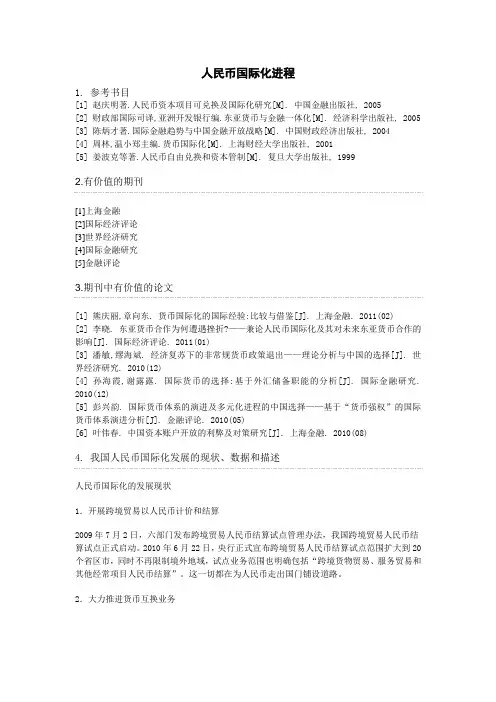
人民币国际化进程1.参考书目[1] 赵庆明著.人民币资本项目可兑换及国际化研究[M]. 中国金融出版社, 2005[2] 财政部国际司译,亚洲开发银行编.东亚货币与金融一体化[M]. 经济科学出版社, 2005[3] 陈炳才著.国际金融趋势与中国金融开放战略[M]. 中国财政经济出版社, 2004[4] 周林,温小郑主编.货币国际化[M]. 上海财经大学出版社, 2001[5] 姜波克等著.人民币自由兑换和资本管制[M]. 复旦大学出版社, 19992.有价值的期刊[1]上海金融[2]国际经济评论[3]世界经济研究[4]国际金融研究[5]金融评论3.期刊中有价值的论文[1] 熊庆丽,章向东. 货币国际化的国际经验:比较与借鉴[J]. 上海金融. 2011(02)[2] 李晓. 东亚货币合作为何遭遇挫折?——兼论人民币国际化及其对未来东亚货币合作的影响[J]. 国际经济评论. 2011(01)[3] 潘敏,缪海斌. 经济复苏下的非常规货币政策退出——理论分析与中国的选择[J]. 世界经济研究. 2010(12)[4] 孙海霞,谢露露. 国际货币的选择:基于外汇储备职能的分析[J]. 国际金融研究. 2010(12)[5] 彭兴韵. 国际货币体系的演进及多元化进程的中国选择——基于“货币强权”的国际货币体系演进分析[J]. 金融评论. 2010(05)[6] 叶伟春. 中国资本账户开放的利弊及对策研究[J]. 上海金融. 2010(08)4. 我国人民币国际化发展的现状、数据和描述人民币国际化的发展现状1.开展跨境贸易以人民币计价和结算2009年7月2日,六部门发布跨境贸易人民币结算试点管理办法,我国跨境贸易人民币结算试点正式启动。
2010年6月22日,央行正式宣布跨境贸易人民币结算试点范围扩大到20个省区市,同时不再限制境外地域,试点业务范围也明确包括“跨境货物贸易、服务贸易和其他经常项目人民币结算”。
人民币国际化文献综述
波动 的方 差 、 金融 中心 大小 等 。具体 来说 , 货币 国际化 的条 件包 括 :
1 .经 济 规 模 及 经 济 开 放 度 。Ma u a a K yt i和 t y m , ioa s k
hn rn e(0 7 定 9 3年 ~ 推进 人 民币 国 际化 . 限制 国内 金融 政 策 选 择 范 围 、 束 度 的 因素 。C in和 Fa k l2 0 ) 量研 究 了 17 将 约 19 9 8年各 国央行 国际储 备 主要 币种 结构 的决 定 因素 。 著 显 人 民币汇 率政策 、 使 中 国遭 遇 “ 里芬 ” 题 。 并 特 难 通 汇 2 .削 弱 政 府 宏 观 政 策 的 自 主 性 及 调 控 力 。 Fak l 变量 包 括 国 际货 币 发 行 国 的经 济 规 模 、 货 膨胀 率 、 率 rn e (9 5 指 出 。 币 国 际化 会 增 加境 外 对 该 国货 币 的需 求 , 19 ) 货 导致 该货 币升值 . 而损 害该 国 出 1产 品在 国际市 场 的竞 从 7 1 争 力 此外 . 货币 国际化 还 会增 加外 国对 本 国货 币需 求 的
一
2 .实现 国国 际收 支赤 字融 资 ,减 少 国际收 支的波 动 。
国 内外学者 的相 关研 究 . 以期对 人 民币 国 际化 的研究 现状 曹 勇 ( 0 3 指 出人 民币 国 际化 有 利 于 我 国通 过 输 出 人 民 还 有利 于输 出通胀 和转 嫁压力 。 陶勇强 、 王智 勇 (0 0 指 出人 民币 国际化 实 现 国际收 支赤 2 l)
降低 金 融机 构在 国 投 资工 具 :3 ( )国际 贸易 中以人 民币结 算 的交 易达 到一 定 际化可 以增 加我 国金融 中介 业 务 收入 . 际市场 筹资成 本 . 高人 民币国 际贷款 利率 。 提 5 .货币行 政 当局 在制 定执 行经 济政 策时 获得优 势 。 王
关于人民币国际化国内研究的文献综述
关于人民币国际化国内研究的文献综述作者:苏凡董继刚杨致瑗来源:《时代金融》2016年第24期【摘要】近日,人民币加入了特别提款权(SDR),进一步推动了人民币国际化的进程。
在此背景下,探讨人民币国际化的相关问题显得尤为迫切。
本文对货币国际化影响因素、程度度量、路径选择等国内研究成果进行了梳理。
以期为我国推进人民币国际化提供借鉴。
【关键词】国际货币人民币国际化风险国内对人民币国际化的研究开始于二十世纪九十年代中期左右,随着中国经济实力的提升和国际地位的提高,关于人民币国际化的讨论不断的升温和深化,很多学者对这一问题进行了多角度的探讨和研究,为我国进一步推动人民币国际化进程提供了助力和参考。
一、人民币国际化的可行性分析研究吴富林(1991)指出,对于货币国际化这一现象,应当结合国际货币的制度背景、国际政治背景以及国际经济形势进行分析,他认为在货币国际化内部条件中,最重要的是一国经济实力。
在货币国际化的外部条件中,国际货币垄断的消除,国际经济的协调以及国际政治的可容行尤为重要。
陈彪如(1998)较早开始了人民币国际化的研究,他认为,人民币国际化需要经历一个长期的过程。
只有循序渐进的与世界各国建立广泛的贸易联系,增加中国在进出口贸易中所占的比重,保持货币价值的稳定,建立完善自由的金融市场,增强政治实力,中国推进人民币国际化才具有现实基础。
赵海宽(2003)提出人民币可能发展成为世界货币之一的论点。
他通过分析几种主要的世界货币指出,较高的国际信用地位,强大的经济基础和先进的银行系统,是一国货币成为国际货币的基础条件。
应当采取积极的态度和措施推进人民币的国际化进程。
孙立和王东东(2005)认为,推进人民币国际化不仅应考虑一系列的政治经济约束性条件,还应认识到,虽然人民币国际化是宏观层面,但微观层面的企业是承担者,应该加强微观层面的发展规划。
张礼卿(2009)指出,虽然中国人民币区域化得到了一定程度的发展,但是考虑到我国的综合经济实力相对较弱,国内金融市场的发达程度欠佳,资本市场的开放度不够等方面,与货币国际化的决定因素存在较大距离,人民币走向国际化仍然任重道远。
人民币国际化问题研究综述
另外 一个 著 名 经济 学家 蒙 代 尔( 2 o o 3 )  ̄ 持有 这 样 一种 看 法 , 他 认为, 当货 币 的流通超 出了原本 的领 域界 限 即可称 为 国际化 。
综上所 述 ,货 币 国际化 可 以理解 为一 个 国家 的货 币演 化跃 进 ,
备中, 人 民币 的百分 比将 可 能 大 幅度上 升 到 1 7 %, 同 时在 国 际债 券 中的 占 比也将 有大 比例 提高 。 综上 所述 , 国内学 者普 遍认 为 , 我 国经济 规 模 的持续 攀升 、 外 汇
储 备 的持续增 长 、 金融 市场 的进 一 步开 放包 容和 充足 的国际 清偿 能
成 为一种 国 际货币 的这 么一 个过 程 。具体 表现 为该 国货 币的职 能 , 力 等 已经为人 民 币 国际化打 下 了坚 实 的基础 。 全部 或者 部分 地从本 国领域 扩展 到其 他 国家 , 进而 扩展 到世 界 上大 2 . 人 民币 国际化 的制 约 因素 部分 国家 。 一 国货 币只有 在 国际上充 当了价值 尺度 、 流通 手段 、 储藏 对 于人 民币 国际化 的制 约 因素 , 国内学 者从 国内因 素和 国外 因 手段 等功 能时 , 才能被 称之 为 国际货 币 。 素 两方 面对 其进行 了剖 析 。 2 . 人 民币 国际化 的定义 及现 状 从 国内 因素方 面 分析 , 层 次 较弱 的监 管 , 不够 发 达 的 国 内金 融 对 于人 民币 国际 化 , 张彦 ( 2 0 1 1 ) 认 为 有 这 么三 个 标 准 , 一个 是 市 场 , 过 于严格 的金融 管制 和不 够合 理 的汇 率制 度等 自身 的缺 陷阻 以人 民 币结算 的交 易在 国际 贸易 中达 到 了一定 的百分 比 ; 国际上 各 碍 了人 民币 国际化 进程 。
人民币国际化研究报告范文
人民币国际化研究报告范文一、背景人民币国际化是指人民币逐渐成为国际交易和储备货币的过程。
自改革开放以来,中国经济的快速崛起使人民币逐渐在国际金融领域崭露头角,引发了各界对人民币国际化的关注。
二、人民币在国际交易中的地位人民币国际化的第一个步骤是提升其在国际贸易中的地位。
近年来,中国不断推动人民币结算和跨境使用的便利化政策,积极推动人民币在全球贸易中的使用。
目前,人民币已成为世界货币供应量前五位的货币之一,并且在中国主要贸易伙伴中占据重要地位。
三、人民币在国际金融市场中的应用人民币国际化的第二个步骤是提升其在国际金融市场中的应用。
中国政府鼓励国内金融机构发展离岸人民币业务,推动人民币在全球范围内的投资和融资活动。
目前,香港是离岸人民币业务最为发达的地区,成为离岸人民币市场的中心。
四、人民币国际化对中国经济的影响人民币国际化对中国经济具有深远影响。
一方面,人民币国际化使中国能够更好地参与全球经济合作与竞争,提高国际话语权。
另一方面,人民币国际化也为中国提供了更多的融资渠道,降低了国际融资成本,推动经济结构转型。
五、人民币国际化的挑战人民币国际化也面临一些挑战。
首先是市场开放度不够高,金融制度方面还存在一些限制。
其次是人民币的国际信用和声誉问题,与美元等国际主要货币相比,人民币在全球范围内的认可度仍有待提高。
此外,国际金融市场的波动和不确定性也对人民币国际化构成一定的压力。
六、人民币国际化的战略意义人民币国际化具有重要的战略意义。
一方面,人民币国际化可以提高中国在全球经济和金融体系中的地位和影响力。
另一方面,人民币国际化也有助于推动全球金融体系的多元化发展,减少对任何一国货币的过度依赖。
七、人民币国际化面临的风险人民币国际化也面临一些风险。
首先是外部环境的不确定性,包括全球经济形势和国际金融市场的波动等因素。
其次是金融风险的传导,一旦中国金融市场出现大规模波动,可能对国际市场造成连锁反应。
此外,在外汇市场的波动和资本流动方面也存在一定的风险。
- 1、下载文档前请自行甄别文档内容的完整性,平台不提供额外的编辑、内容补充、找答案等附加服务。
- 2、"仅部分预览"的文档,不可在线预览部分如存在完整性等问题,可反馈申请退款(可完整预览的文档不适用该条件!)。
- 3、如文档侵犯您的权益,请联系客服反馈,我们会尽快为您处理(人工客服工作时间:9:00-18:30)。
人民币国际化相关的文献综述
国际国内关于货币国际化的研究,国外研究起步相对较早,理论也相对较成熟。
国内研究基本从20世纪80年代末90年代初才开始,国内的研究主要围绕人民币国际化这一主题展开。
一、国外文献综述
由于国外学者对货币国际化的研究较早,理论也相对较成熟。
通过对国际货币形成的历史的研究和探讨,通过对国际货币使用情况和国际货币格局变化的分析,西方学者对国际货币的一些特性和影响进行了归纳和总结,并主要从不同的角度对货币国际化的条件和影响两方面进行了探讨。
(一)货币国际化的定义、特性以及条件
Cohen(1971)最早从货币职能的角度定义国际货币,他认为国际货币的职能是货币国内职能在国外的扩展。
部门和官方机构出于各种各样的目的将一种货币的使用扩展到该货币发行国以外时,这种货币就发展到了国际货币的层次。
Hartmann (1998)进一步发展了Cohen的定义,他对国际化货币的不同职能进行了分类:作为支付手段,国际化货币在国际贸易和资本交易中被私人用作媒介货币,在外汇市场干预中被官方用作干预工具;作为记账单位,国际化货币被用于商品贸易和金融交易的计价,被官方部门用于确定汇率平价;作为价值储藏手段,国际化货币形成的金融资产是构成私人部门资产组合的主要部分,也是构成官方储备资产的源泉`。
蒙代尔(2003)则从货币流通范围的角度给出了货币国际化的定义,他认为,当货币流通范围超出法定的流通区域,该货币就国际化了。
判断一国货币是否国际化,一般主要有以下几个标准:(1)该国货币自由兑换在国际交易支付中所占的比重;(2)该国货币是否发挥执行价格标准,国际清算货币的作用;(3)该国货币在国际投资中所占的比重;(4)该国货币是否发挥国际储备资产的职能(国际储备货币);
(5)该国货币在国际借贷活动中所占的比重;(6)该国货币是否具有国际干预货币的作用;(7)该国货币是否在世界范围内发挥价值尺度。
最早涉及货币国际化条件的研究来自于Grassman(1973)。
他通过考察丹麦和瑞典贸易中的计价货币,发现无论是丹麦还是瑞典,都有习惯以生产者使用的货币作计价货币的行为,这一发现后来被称Grassman定律。
Bergstern (1975)提出货币国际化的四个条件:第一是历史惯性。
在20世纪早期,英国的国际贸易规模、经济规模已经没有优势,但人们已经习惯使用英镑,英镑仍作为当时国际的主要货币,主要是历史惯性;第二,该国的金融规模与国际贸易。
通常,一国在国际金融和国际贸易中所占比例越大,非居民对该国货币的需求就越大;第三,发达而开放的金融市场。
非居民持有一国货币,必然是因为有增值保值的需求,这就需要有一个可交易的金融市场提供给该国货币;第四,对该国货币价值的信心。
一国货币作为储藏手段和国际支付,从内在来看,要求其保持稳定的价值。
美元在1973年至1990年间累计跃值了 47%,导致美元在国际储备中的份额也有所下降。
Krugman (1980)认为,作为国际交易媒介货币(vehicle currency),即国际本位货币,交易成本(包括信息成本、转换费用等)必须最低。
而交易成本是随着交易量的增加而递减的,因此,具有最低交易成本,即具有最大交易量的货币,会成为国际媒介货币
Wincoop(2002)在研究制成品贸易中本国货币和贸易伙伴国货币的计价选择时发现,决定计价货币选择的两个主要因素是:市场份额和产品差异度。
他认为,出口国产品所占的市场份额越高,产品的差异度越大,可替代性越低,出口商越可能以本国货币定价。
(二)货币国际化的影响
Swoboda(1968,1969)强调在外汇市场交易成本的作用和低交易成本使用货币的收益。
Portes 和 Rey(1998)指出低交易成本可以反映出外汇市场货币的高度流动性。
Krugman(1980)研究认为一旦一种货币在本区域市场成为决定性货币,那么公司没有动机去使用另外一种替代货币计价,这样会导致一种更高的交易成本和相对其他竞争对手的价格波动所导致的销售波动。
一旦一种货币发挥这种突出的作用,那么甚至出现另一种货币也有同样的低成本,这种作用也会持续。
Giovanini(1988)研究生产者利润最大化和交易贸易中进出口货币的选择之间的波动问题。
Wilander(2006)研究了外汇波动在瑞典出口计价中的作用。
综上所述,1、货币国际化是市场选择的结果,市场选择则依赖于:政治安稳、贸易规模、经济规模、投资份额、金融市场、货币价值及产品的差异度等。
2、一国货币在国际上话语权取决于该国的综合国力。
3、货币的国际影响力越大,货币国际化收益越大,成本越小;国际地位越低,则成本可能会高于收益。
二、国内文献综述
国内关于货币国际化的文献研究从学习研究主要国际货币国际化的经验开始,总结经验和教训,为人民币国际化提供借鉴。
其后从人民币本身出发,研究人民币国际化的可行性、条件、路径选择。
早期的理论界对于人民币国际化问题的研究基本等同于对人民币如何实现自由兑换的研究。
理论界对货币国际化的一般条件及规律出发,对人民币国际化的必要性、可行性、成本收益等问题做了较为深入的探讨,同时也提出了人民币国际化的发展阶段和战略构想(姜波克,1994;胡定核,程海泳,1996)。
李建军和田光宁(2003)考察了当今世界三大货币的国际化过程,他们认为,美元国际化路径依赖的是全球性汇率协作制度安排,欧元国际化路径依赖的是货币主权联邦制的区域性制度安排,日元国际化路径依赖的是实体经济发展与金融深化政策。
在竞争日趋激烈的国际经济环境中,人民币国际化只有依托我国综合国力的提升、国际地位的提高来逐步实现。
这需要大陆、香港、澳门和台湾形成一个强大的经济体,四种货币可以融合为单一货币,实现国际化。
张青龙(2005)研究了20世纪60年代以来西方关于货币国际化的理论,总结出了三个方面的主要内容:第一,国际货币及货币国际化的含义以及界定边界;第二,货币国际化的条件;第三,货币国际化对内外均衡的影响。
通过这三方面内容的梳理分析货币国际化的一般规律,为人民币国际化提供参考。
对人民币国际化的条件分析有:温小郑(1996)指出,币值稳定、贸易强势、金融市场发达等是我国货币国际化的前提条件。
曹红辉(2006)则认为,我国已经实现了区域国际化进程,在东南亚市场占据主要地位,这为人民币国际化做了良好的基础。
姜波克(1999)认为,人民币国际化的条件主要有以下几点:(1)中国经济必须保持高速增长,保持在亚洲的领先增长地位;(2)出口以人民币作为主要结算货币;(3)人民币可兑换是人民币国际化的前提;(4)在周边国家和地区设立中国银行的分支机构,接受人民币存款,为该国政府、企业和民间流动的人民币提供存储渠道。
在人民币国际化选择路径方面,姜波克(1999)提出了以直接投资和贸易为手段加强与周边国家和地区联系,向周边国家提供中短期人民币出口信贷,建立起有效促进我国与世界联系的金融市场。
张宇燕(2008)对国际货币进行了成本收益分析,提出首先应通过亚洲货币合作机制的发展实现人民币国际化战略的初级阶段目标。
曾远征和周航(2009)具体分析了人民国际化的逻辑顺序:人民币先是作为结算货市,再作为投资货币,再作为国际融资货币,
最后成为各国央行干预金融市场的主要干预货币。
人民币计价结算是人民币国际化的基础,是当前推进重点。
通过促进人民币用于国际贸易结算,推进国际贸易中使用人民币作为结算货币的便利程度和使用范围。
在人民币与我国外汇储备管理方面,孔立平(2010)以马柯维兹资产组合理论为基础,同时结合海勒一奈特模型和杜利模型,对影响储备币种结构的因素进行全面系统的分析。
在考虑外汇储备风险和收益的同时,综合考虑我国的贸易结构、外债结构、外商直接投资来源结构和汇率制度对我国外汇储备进行最优币种结构配置,提出了中国当前合理的储备币种权重,并提出从长期看应逐步减持美元、增持欧元、同时积极推进人民币国际化的建议。
在人民币国际化与人民币离岸市场方面,员瑜平(2012)认为“纯离岸型”和“国际借贷流出型”的离岸市场有利于推动货币国际化进程,而“纯往返型”和“国际借贷流入型”的离岸市场往往加大本国的经济风险。
当前人民币国际化和香港离岸市场的发展出现放缓,是由于人民币单边升值预期的减弱使人民币在贸易项下的流出减少,这一状况将长期持续。
目前人民币离岸市场以“国际借贷流入型”为主,这一“倒逼回流”的现状急需转变,短期内应当通过离岸人民币贸易融资培育“纯离岸型”市场,实现功能转型,中长期需要以扩大人民币对外直接投资培育“国际借贷流出型”市场,提升离岸人民币存量。
综上所述,大多数学者和业内人士对人民币国际化持有乐观和积极态度,也提出了许多宝贵的建议与意见。
随着我国综合国力的逐步增强,经济实力不断提高,参与国际经济的深度不断扩展,人民币国际化已经成为大势所趋,2015年人民币加入国际货币篮子就是最好的明证,但我们也应该清楚地认识到人民币国际化是个长期的过程,还有很长的路要走。
同时我国对人民币国际化的研究还需进一步加深,例如尽管很多学者和业界人士明知离岸市场正在积蓄着不可忽视的金融风险,但是对于这种风险的源头却并不清楚。
另一方面这些理论需要时间的检验。
